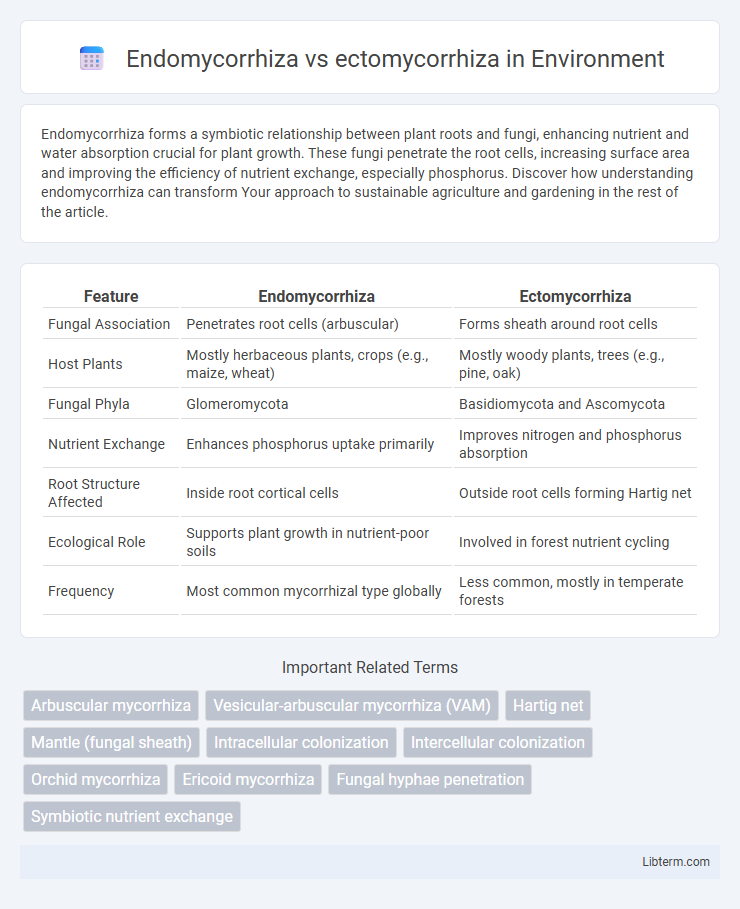Endomycorrhiza forms a symbiotic relationship between plant roots and fungi, enhancing nutrient and water absorption crucial for plant growth. These fungi penetrate the root cells, increasing surface area and improving the efficiency of nutrient exchange, especially phosphorus. Discover how understanding endomycorrhiza can transform Your approach to sustainable agriculture and gardening in the rest of the article.
Table of Comparison
| Feature | Endomycorrhiza | Ectomycorrhiza |
|---|---|---|
| Fungal Association | Penetrates root cells (arbuscular) | Forms sheath around root cells |
| Host Plants | Mostly herbaceous plants, crops (e.g., maize, wheat) | Mostly woody plants, trees (e.g., pine, oak) |
| Fungal Phyla | Glomeromycota | Basidiomycota and Ascomycota |
| Nutrient Exchange | Enhances phosphorus uptake primarily | Improves nitrogen and phosphorus absorption |
| Root Structure Affected | Inside root cortical cells | Outside root cells forming Hartig net |
| Ecological Role | Supports plant growth in nutrient-poor soils | Involved in forest nutrient cycling |
| Frequency | Most common mycorrhizal type globally | Less common, mostly in temperate forests |
Introduction to Mycorrhizal Associations
Endomycorrhiza forms symbiotic relationships where fungal hyphae penetrate root cortical cells, enhancing nutrient exchange and soil phosphorus uptake. Ectomycorrhiza surrounds root tips with a fungal sheath without penetrating root cells, primarily aiding host trees in nitrogen and water absorption. Both types establish mutualistic associations vital for plant growth, soil health, and ecosystem nutrient cycling.
Defining Endomycorrhiza and Ectomycorrhiza
Endomycorrhiza, also known as arbuscular mycorrhiza, is a symbiotic association where fungal hyphae penetrate the root cortical cells, forming structures called arbuscules that facilitate nutrient exchange. Ectomycorrhiza involves fungi forming a dense sheath around the root tips and extending into the intercellular spaces of the root cortex without penetrating the cell walls, creating a Hartig net for nutrient transfer. These two mycorrhizal types differ mainly in fungal colonization patterns and host plant specificity, affecting their ecological roles and nutrient acquisition strategies.
Structural Differences Between Endomycorrhiza and Ectomycorrhiza
Endomycorrhiza forms intracellular hyphal structures called arbuscules inside root cortical cells, facilitating nutrient exchange directly within the cell. Ectomycorrhiza develops a dense fungal sheath around root tips and a Hartig net between root epidermal and cortical cells, without penetrating the cell walls. These structural differences influence their symbiotic interactions and nutrient absorption mechanisms in host plants.
Host Range and Plant Compatibility
Endomycorrhiza, primarily arbuscular mycorrhizal fungi (AMF), form symbiotic relationships with a wide range of herbaceous plants, including over 80% of terrestrial plant species such as grasses, legumes, and crop plants. Ectomycorrhiza are mostly associated with woody plants, including temperate and boreal tree species like pines, oaks, and birches, showing a narrower host range compared to endomycorrhiza. Plant compatibility varies as endomycorrhiza penetrate root cortical cells, facilitating nutrient exchange, while ectomycorrhizal fungi form an external mantle around roots without penetrating cells, influencing species-specific interactions.
Mechanisms of Nutrient Exchange
Endomycorrhiza penetrates root cortical cells, forming arbuscules that facilitate direct nutrient exchange between fungal hyphae and plant cells, enhancing phosphorus uptake. Ectomycorrhiza surrounds root tips with a fungal mantle and forms a Hartig net between epidermal and cortical cells, enabling the transfer of nutrients like nitrogen and phosphorus without breaching the cell walls. These distinct structures allow both symbioses to efficiently mobilize and exchange nutrients, optimizing plant nutrition in varying soil environments.
Ecological Roles and Environmental Impact
Endomycorrhiza forms symbiotic associations primarily with herbaceous plants, enhancing nutrient uptake, especially phosphorus, and improving soil structure and plant resilience in diverse ecosystems. Ectomycorrhiza associates mainly with woody plants, playing a crucial role in forest nutrient cycling by decomposing organic matter and facilitating nitrogen and carbon fluxes, which supports plant health and forest productivity. Both types significantly influence ecosystem stability, soil biodiversity, and carbon sequestration, contributing to climate regulation and habitat sustainability.
Benefits to Plants: Growth and Stress Tolerance
Endomycorrhiza enhances plant growth by penetrating root cells, improving nutrient uptake, especially phosphorus, and boosting tolerance to drought and soil salinity. Ectomycorrhiza forms a dense sheath around roots, facilitating nutrient exchange and providing protection against soil pathogens, which increases plant resilience in nutrient-poor environments. Both types of mycorrhiza symbiosis improve plant stress tolerance by optimizing water absorption and strengthening immune responses.
Applications in Sustainable Agriculture
Endomycorrhiza, particularly arbuscular mycorrhizal fungi (AMF), enhance nutrient uptake by penetrating root cells, promoting phosphorus absorption and improving plant resilience to drought and pathogens, making them vital in sustainable agriculture for reducing chemical fertilizer use. Ectomycorrhiza form a dense sheath around root tips, aiding in nitrogen and phosphorus acquisition, especially in forest and orchard crops, contributing to soil health and long-term productivity. Integrating both mycorrhizal types in cropping systems supports soil biodiversity, improves crop yields, and fosters eco-friendly farming practices.
Challenges in Identification and Research
Endomycorrhiza and ectomycorrhiza differ significantly in their structural colonization of plant roots, creating challenges in precise identification that often require microscopic and molecular tools for differentiation. Research complexities arise from the diverse symbiotic relationships and environmental influences affecting their development, necessitating advanced genetic sequencing and imaging techniques for accurate characterization. Understanding these distinctions is crucial for applications in agriculture and ecosystem management, as misidentification can hinder the optimization of mycorrhizal interactions for plant health and soil fertility.
Future Perspectives and Research Directions
Endomycorrhiza research is advancing towards genetic modification and improved crop resilience, emphasizing symbiotic nutrient exchange efficiency to enhance sustainable agriculture. Ectomycorrhiza studies are focusing on ecosystem restoration, soil health, and carbon sequestration, aiming to leverage fungal-host interactions for climate change mitigation. Future directions include integrating multi-omics approaches and artificial intelligence to unravel complex signaling pathways and develop biofertilizers tailored for diverse environmental conditions.
Endomycorrhiza Infographic

 libterm.com
libterm.com